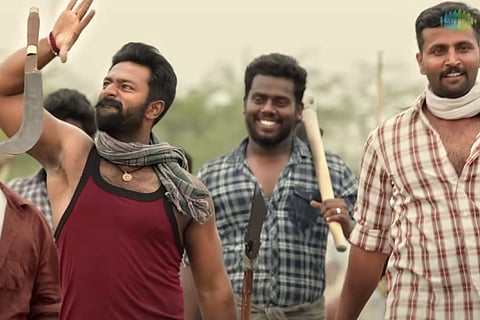

In one of the opening shots of Raavana Kottam, you see Bose (played by Prabhu) at the door of his house with nine other faux heads. The heads are actually photos hung in Bose’s house and belong to various leaders like Dr BR Ambedkar, Muthuramalinga Thevar, late LTTE chief Prabhakaran, Periyar, and Subhash Chandra Bose, among others. This clever camera trick featuring an ideologically varied medley of leaders sets the tone for the confusing politics employed in the film.
Written and directed by Vikram Sugumaran, Raavana Kottam features Shanthanu Bhagyaraj, Anandhi, and Prabhu in lead roles. The movie is set in the ‘caste-free’ utopian village of Enathi in the Ramnad district. Even politicians are not allowed inside Enathi to prevent them from creating caste-based divisions among residents.
Within the first few scenes of the film, the director tries hard to establish the ‘no caste’ nature of the place, emphasising how residents (mostly men) from the ‘melatheru’ and ‘keezhatheru’ are like pangalis (loosely refers to brothers or cousins). But the terms ‘melatheru’ and ‘keezhatheru’ themselves have casteist connotations and are used to refer to streets exclusively occupied by people from the dominant and lowered castes, respectively.
Bose, the unofficial head of the village, hails from the ‘melatheru’. He embodies some ideological remnants of the naatamai (head of the village, usually from a dominant caste) characters that dominated 90s Tamil cinema. Several dialogues in the film come from Bose’s counterpart Velu (played by Ilavarasu), who hails from the ‘keezhatheru’, chiding his brethren to be grateful for what Bose’s ancestors have done for them.
While both of them are apparently equal and in charge of Enathi, Velu does not command the respect Bose does. In fact, he is introduced as an alcoholic who creates a scene at a bar. But after this intro scene, there is no mention of Velu’s drinking habit.
From what seems like an anti-caste drama in the beginning, Raavana Kottam quickly loses track and adopts the formulaic Tamil cinema trope of a village fighting a faceless corporate villain who wants to create trouble in paradise. Before the audience can grasp what is happening, corporate companies, karuvelai trees, agriculture, and water scarcity are thrown into the mix without delving deep into any of their complexities.
The troublemakers, who are somehow always from the ‘keezhatheru’, want to create a caste divide for the benefit of a politician who has ties with a corporate company that wants to extract minerals from Enathi. Our dominant caste hero tries to save the day as his best friend Madhi is in the wrong and realises his mistake a bit too late. No surprises there.
Shanthanu Bhagyaraj settles comfortably into his character Senguttuvan, a charming, feisty ruffian, who is always ready for a fight. Departing from his usual urban boy-next-door roles, his performance almost makes up for the other failings in the film. Meanwhile, the female characters are unsurprisingly disappointing. Anandhi as Indira Priyadharshini has little to no active role in the film apart from playing a love interest. We know nothing about Indira, except that she and Senguttuvan are secretly in a relationship. Deepa Shankar, who plays Shanthanu’s sister, remains underutilised.
The romance between Senguttuvan and Indira is also deeply problematic. It begins with Senguttuvan kissing Indira without consent before a crowd during her puberty ceremony. Why? Because he was not allowed to garland Indira despite being her murai mama (a marriageable cousin), and because he wanted to settle scores with her mother for ‘humiliating’ him and his sister. While Indira is deeply shocked, she is shown to slowly embrace this violation of consent. She eventually demands that Senguttuvan marry her because nobody else will.
Though Raavana Kottam has an interesting plotline and fitting background score that maintains tension, there is little to redeem the no-nuance script. The film falls into a trap of cliches while trying hard to give a hot take on caste discrimination.
Disclaimer: This review was not paid for or commissioned by anyone associated with the film. Neither TNM nor any of its reviewers have any sort of business relationship with the producers or any other members of its cast and crew.